The History Of Buick Roadmaster

The Roadmaster was an automobile built by the Buick division of General Motors. Buick first used the Roadmaster name between 1936 and 1958. In 1991, Buick again applied the Roadmaster name to its full-size rear-wheel drive sedan and station wagon models as a replacement for the Buick Estate.
The origins of the Roadmaster name date to 1936 when Buick renamed its entire model lineup to celebrate the engineering improvements and design advancements over their 1935 models. Buick's Series 40 model range became the Special, the Buick Century took the place of the Series 60 and the Series 90 — Buick's largest and most luxurious vehicles — became the Limited. Buick's Series 80 became the Roadmaster.
Roadmasters produced between 1936 and 1958 were built on Buick's longest wheelbase and shared its basic structure with senior Oldsmobiles. Between 1946 and 1957, the Roadmaster was Buick's premium and best appointed model, and was offered in sedan, coupe, convertible and station wagon bodystyles between 1936 and 1948. In 1949 a hardtop coupe, designated "Riviera" joined the model line up; a four-door hardtop joined the model range in 1955.
The 1953 Buick Roadmaster station wagon, Model 79-R, was the last wood-bodied station wagon mass-produced in the United States. Its body was a product of Iona Manufacturing which built all Buick station wagon bodies between 1946 and 1964. Priced at US$4,031, the wagon was second in price to the Buick Skylark. Only 670 of these final woody wagons were produced for 1953.
In 1959, Buick again introduced a model range that represented a significant shift in its body design, and the Roadmaster was renamed the Electra.
Buick revived the Roadmaster name for a B-body station wagon in 1991, replacing the Estate station wagon in the lineup. The wagon was called the Roadmaster Estate Wagon. A sedan joined it for 1992. The Roadmaster wagon was very similar to its sisters Chevrolet Caprice and Oldsmobile Custom Cruiser; in 1993, the newly-redesigned Cadillac Fleetwood also resembled the Roadmaster and Caprice sedans--except that it featured chrome-plated front and rear bumpers and was much more expensive.
Standard on all Roadmaster Estate Wagons were woodgrain sides (except when special-ordered with option WB4 wood delete) and a "Vista Roof", a fixed sunroof over the second row seats. The Estate Wagon could seat up to eight with an optional third row seat. All these wagons initially used Chevrolet's 5.0L small-block V8, but both Buicks used the larger 5.7L version from 1992.
GM discontinued both the Roadmaster sedan and the Roadmaster Estate Wagon in 1996. This was blamed on the smaller but more expensive and luxurious Park Avenue growing in size; the Roadmaster trim levels never exceeded that of the smaller but still full-sized Buick LeSabre. Another reason was largely a response to the SUV craze, as the Arlington, Texas factory where RWD GM cars were built was converted to truck and SUV production. When discontinued, the Roadmaster Estate and the similar Chevrolet Caprice wagon brought up the end of the era of the full-size family station wagon, and an end to General Motors' production of rear-wheel drive, full-size cars.
Year-to-year changes
- 1992: A 4-door sedan joined the Roadmaster wagon as an early 1992 model, carrying the 5.7L TBI (Throttle-Body Injection) V8 engine that developed 180hp. That engine also went into the Estate Wagon, replacing the 5.0L.
- 1993: Window lockout feature and the addition of a new spoke wheel cover mid-year.
- 1994: A redesigned dashboard included a new instrument cluster, with climate controls mounted higher and a knee bolster below. Dual airbags were also installed. The 5.7L TBI is replaced with a detuned 5.7L LT1 engine from the Chevrolet Corvette. This LT1 had cast iron cylinder heads and produced 260hp (194kW) (40 less horsepower than the Corvette). A new electonically controlled 4L60-E 4-speed automatic transmission replaces the 4L60.
- 1995: Only a handful of minor changes were made to 1995 models, including long-life automatic-transmission fluid. Larger, foldaway style mirrors were installed as well, and radios received bigger controls. Sedans wore new bodyside moldings, while Estate wagons added a shade for the "Vista Roof" as well as a cargo cover. Heated seats also became an option.
- 1996: Final year. Engine coolant could last 5 years or 100,000miles (160,934km), and automatic climate control became standard. The General also updated the onboard diagnostic system (OBD I to OBD II). The Roadmaster Estate Wagon and the Chevrolet Caprice wagon would be the last American full-size station wagons until the introduction of the Dodge Magnum in 2005.
- A Buick Roadmaster Estate Wagon (exact year unknown, but a 1991 to 1996 model) driven by George Clooney (playing the character Harry Pfarrer) appears in the movie Burn After Reading.
- Janet Evanovich's fictional bounty hunter Stephanie Plum occasionally drives a powder blue '53 Roadmaster, nicknamed "Old Blue," when she has no other options, such as her car's frequently being destroyed. The car belongs to her Grandma Mazur, who received it from Stephanie's Uncle Sandor.
- An object of unknown origin bearing a close resemblence to this car is the titular feature of the Stephen King novel From a Buick 8.
- Von Humboldt Fleisher drove a Roadmaster in Saul Bellow's novel Humboldt's Gift.
- A 1949 Roadmaster plays a vital role in the movie Rain Man as the only link between Charlie and Raymond Babbitt.
- A beautifully restored 1949 Roadmaster (actually there were two used) is the principal vehicle used in the 1996 movie Mulholland Falls.
- Jack Nicholson and Leonardo DiCaprio's characters were driven around in a 1994 Buick Roadmaster in the movie The Departed although the car is rarely seen from the outside.
- A 1948 Buick Roadmaster hearse is the car Neil Young drove from his home in Canada the entire distance to L.A where he started his solo career. He also wrote an elegy dedicated to it, "Long May You Run".
- This car is also featured in the movie "City Hall" in which a city official committed suicide inside his Buick Roadmaster.
- In the suspense novel Paranoia by Joseph Finder, fictional CEO Augustine Goddard drives a 1949 Roadmaster that he fully restored.
From Wikipedia, the free encyclopedia
More About Buick Roadmaster
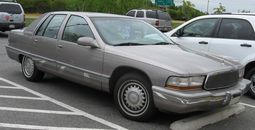
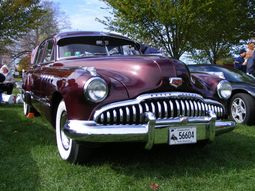
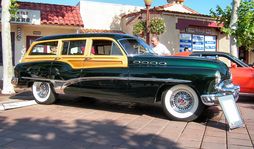
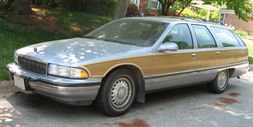
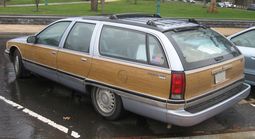
|